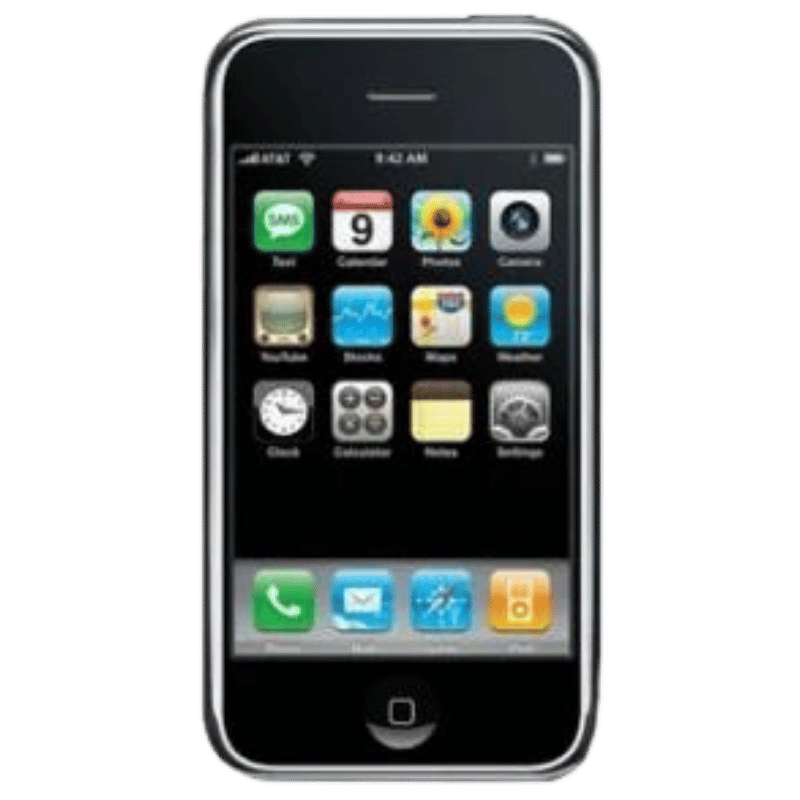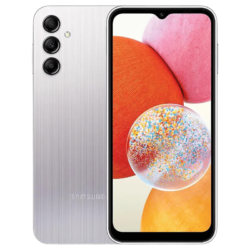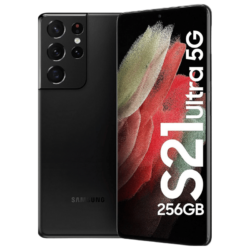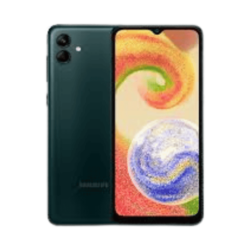Apple iPhone first generation
QR 1,000
The price for this iconic piece of technology ranges from 1,000 to 2,500 Qatari Riyal (QAR), depending on its condition and storage capacity. This pricing reflects its historical significance rather than its practical use in today’s fast-paced digital world.
Specifications of the Apple iPhone First Generation
| Feature | Specification |
|---|---|
| Display | 3.5″ TFT capacitive touchscreen |
| Resolution | 320 x 480 pixels |
| Processor | Samsung 32-bit RISC ARM 11 412 MHz |
| RAM | 128 MB eDRAM |
| Storage | 4GB / 8GB / 16GB |
| Main Camera | 2 MP |
| Front Camera | None |
| Battery | 1400 mAh Li-Ion |
| Operating System | iPhone OS 1.0 (upgradable to iPhone OS 3.1.3) |
| Connectivity | 2G (GSM 850/900/1800/1900), Wi-Fi 802.11b/g, Bluetooth 2.0 |
| Dimensions | 115 x 61 x 11.6 mm |
| Weight | 135 g |
| SIM | Mini-SIM |
Release Date and Initial Reception
The Apple iPhone first generation was unveiled by Steve Jobs on January 9, 2007, at the Macworld Conference & Expo in San Francisco. However, it wasn’t until June 29, 2007, that this groundbreaking device hit the shelves in the United States. The global rollout followed later, with Qatar and other Middle Eastern countries receiving the iPhone in subsequent years.
When it was first released, the iPhone was met with a mix of excitement and skepticism. Some praised its innovative touchscreen interface and sleek design, while others questioned the lack of a physical keyboard and its high price point. Despite the initial doubts, the iPhone quickly gained popularity and set the standard for smartphones to come.
Multi-touch Interface
The iPhone’s capacitive touchscreen allowed for intuitive multi-touch gestures, making navigation and interaction more natural than ever before.
Full Web Browsing Experience
Unlike many mobile phones of its time, the iPhone offered a full web browsing experience with Safari, displaying web pages as they would appear on a computer.
Visual Voicemail
This feature allowed users to see a list of voicemails and choose which ones to listen to, rather than having to listen to them in order.
iPod Integration
The iPhone seamlessly integrated iPod functionality, allowing users to carry their music library in their pocket along with their phone.
App Store (Introduced Later)
While not available at launch, the App Store was introduced in 2008 with iPhone OS 2.0, revolutionizing the way we use smartphones by allowing third-party developers to create and distribute apps.
The iPhone’s Impact on the Smartphone Industry
The introduction of the iPhone marked a paradigm shift in the mobile phone industry. It set new standards for user interface design, mobile web browsing, and the integration of multiple functions into a single device. The iPhone’s success prompted other manufacturers to develop similar touchscreen-based smartphones, leading to the smartphone revolution we’ve witnessed over the past decade and a half.
iPhone 3G: The Next Step Forward
Released in 2008, the iPhone 3G built upon the foundation laid by its predecessor. The most significant upgrade was the addition of 3G cellular network support, which greatly improved data speeds for web browsing and downloading. The iPhone 3G also introduced GPS capabilities, allowing for more accurate location services and navigation. Physically, it sported a slightly curved plastic back instead of the aluminum body of the first generation, making it more comfortable to hold. The App Store was launched alongside the iPhone 3G, opening up a world of possibilities for third-party developers and users alike.
iPhone 3GS: Speed and Refinement
The iPhone 3GS, released in 2009, focused on performance improvements. The “S” stood for speed, and this model delivered with a faster processor and more RAM. It also introduced video recording capabilities, a feature absent in previous models. The 3GS came with a higher-resolution 3-megapixel camera that included autofocus and macro mode. Voice control, the precursor to Siri, made its debut on this model, allowing users to perform basic tasks through voice commands. While visually similar to the 3G, the 3GS offered significant internal upgrades that improved the overall user experience.
iPhone 4: A Design Revolution
The iPhone 4, launched in 2010, marked a significant departure from its predecessors in terms of design and features. It introduced the iconic glass and stainless steel design that would influence smartphone aesthetics for years to come. The iPhone 4 boasted a high-resolution “Retina Display,” which doubled the pixel density of previous models, resulting in incredibly sharp text and images.
It also introduced a front-facing camera, enabling FaceTime video calls and selfies. The rear camera was upgraded to 5 megapixels with HD video recording capabilities. Powered by the A4 chip, the iPhone 4 offered improved performance and multitasking abilities.
Comparison with the First Generation
When compared to the first-generation iPhone, these later models showcased the rapid evolution of smartphone technology:
- Network Connectivity: While the original iPhone was limited to 2G networks, subsequent models introduced 3G and eventually 4G capabilities, dramatically improving data speeds.
- Processing Power: Each new model brought significant improvements in processing speed and capabilities, with the iPhone 4’s A4 chip being leagues ahead of the first generation’s processor.
- Camera Technology: From the basic 2-megapixel fixed-focus camera of the original, later models introduced higher resolutions, autofocus, and eventually front-facing cameras for video calls.
- Display Technology: The progression from the 3.5-inch 320×480 display of the first generation to the Retina Display of the iPhone 4 demonstrated huge leaps in screen quality and user experience.
- Software Capabilities: With each new model and iOS update, the iPhone gained new features and capabilities, from the introduction of the App Store to advanced voice control features.
The Legacy of the First Generation iPhone
The first-generation iPhone, despite its limitations by today’s standards, laid the groundwork for the modern smartphone era. Its intuitive user interface, full web browsing capabilities, and integration of phone, iPod, and internet communicator set a new standard for what a mobile device could be.
Impact on Mobile Computing
The iPhone’s introduction marked the beginning of the end for many traditional mobile phone manufacturers who failed to adapt to the new touchscreen paradigm. It also blurred the lines between phones, portable media players, and personal digital assistants (PDAs), eventually leading to the convergence of these devices into the smartphones we know today.
Influence on App Development
While the App Store wasn’t introduced until the iPhone 3G, the first-generation iPhone’s web capabilities and user interface design inspired developers to think differently about mobile software. This paved the way for the app ecosystem that would later flourish, transforming how we interact with technology in our daily lives.
Design Philosophy
The iPhone’s minimalist design, with its single home button and large touchscreen, influenced the aesthetic of smartphones for years to come. This design philosophy extended beyond hardware to software, with the iPhone OS (later iOS) setting new standards for mobile user interfaces.
Collecting and Preserving the First Generation iPhone
As the years have passed, the first-generation iPhone has become a sought-after collector’s item. Tech enthusiasts and Apple fans in Qatar and around the world seek out these devices for their historical significance.
Preservation Challenges
Keeping a first-generation iPhone in working condition presents several challenges:
- Battery degradation: The lithium-ion batteries in these devices have a limited lifespan and may have significantly degraded over time.
- Obsolete software: The original iPhone can only be updated to iPhone OS 3.1.3, which is incompatible with many modern web standards and apps.
- Limited connectivity: With the phasing out of 2G networks in many countries, these devices may no longer be able to connect to cellular networks.
Value as a Collector’s Item
The value of a first-generation iPhone can vary greatly depending on its condition, storage capacity, and whether it’s still in its original packaging. In Qatar, prices for these devices can range from 1,000 QAR for used models in fair condition to over 10,000 QAR for sealed, never-opened units.
What Made the First iPhone Special?
Reflecting on the first-generation iPhone, several key factors contributed to its groundbreaking nature:
- Simplicity: The iPhone’s user interface was intuitive and easy to use, a stark contrast to the complex menus of many contemporary phones.
- Integration: By combining a phone, iPod, and internet device, the iPhone offered a level of integration previously unseen in mobile devices.
- Full Web Experience: Unlike the limited WAP browsers of other phones, the iPhone offered a desktop-like web browsing experience.
- Touch Interface: The multi-touch screen allowed for natural gestures like pinch-to-zoom, revolutionizing how we interact with mobile devices.
- Visual Design: Both the hardware and software design of the iPhone set new standards for aesthetics in technology.
The iPhone’s Influence on Modern Technology
The impact of the first-generation iPhone extends far beyond the smartphone market. Its influence can be seen in various aspects of modern technology:
Touchscreen Interfaces
The iPhone popularized capacitive touchscreens and multi-touch gestures, which are now ubiquitous in devices ranging from tablets to car infotainment systems.
App Ecosystems
The concept of a centralized app store, introduced with the iPhone 3G but conceived with the original iPhone, has become a standard feature across all major mobile platforms.
Mobile-First Design
The iPhone’s full web browser encouraged developers to create mobile-friendly websites, eventually leading to the “mobile-first” design philosophy prevalent today.
Personal Computing
The success of the iPhone and its successors has led to a shift away from traditional personal computers for many everyday tasks, with smartphones becoming the primary computing device for many users.





Reviews
There are no reviews yet.